Peripheral Neuropathy & The ReBuilder
"The ReBuilder System
Effective Treatment for Neuropathy and Chronic Pain"
- A Monograph by
Inventor David B. Phillips,
Ph. D.
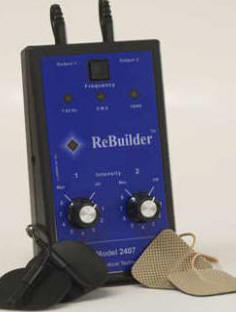 The
ReBuilder® Treatment System is designed to
be simple to use in the home or in the physician’s
office, is non-invasive, safe, effective,
affordable, is registered with the FDA, and is
covered by many insurance plans. The ReBuilder®
unit has simple to use controls, uses electrode pads
that are placed directly on the bottoms of both feet
or on the affected body part. It has no interaction
with, nor does it interfere with, any medications
the patient may be taking. Having a much more
powerful electrical impulse than that of the human
body, the ReBuilder® re-polarizes and re-educates
the nerves to follow the correct paths. It also
enables nerve impulses to jump the synaptic
junction, reconnect the injured nerve cells, and
deliver minerals and nutrients which revitalize
those nerves. When this is accomplished, it
promotes new nerve growth, restores blood
circulation, returns feeling to the patient’s
extremities, and reduces pain. In many cases the
ReBuilder® actually reverses neuropathy and chronic
pain symptoms and restores nerves to their normal
state allowing them to fully function on their own
reducing the need for medications.
Neuropathy and chronic pain: The Condition
Neuropathy
and chronic pain is
characterized by pain, numbness, loss of tactile
feedback, and poor tissue perfusion. These symptoms
may indicate that oxygen is not getting to all the
cells causing dysfunction.
Because the patient’s
quality of life is decreased, these results are
often devastating. Pain medications do not cure the
condition; it only helps mask it and, eventually,
leads to complications with adverse side effects
such as mental confusion and intestinal problems.
As a result of conducting our own research and
reviewing published studies from around the world,
we have been led to new models concerning the causes
of neuropathy and chronic pain. We have concluded
that it is not reasonable to merely label neuropathy
and chronic pain symptoms as diabetic, peripheral,
vascular, or "idiopathic". What is needed is a more
full understanding of the etiology of the condition
so new technology can be brought to bear with both
ameliorative and therapeutic benefits.
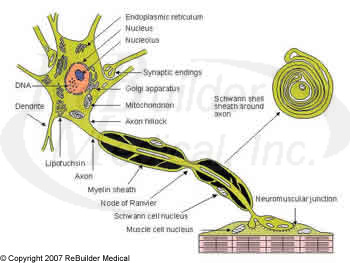
Figure 1: Anatomy
of a nerve cell
Neuropathy
and chronic pain results when
nerve signal propagation is reduced between adjacent
nerve cells due to insufficient oxygen being
available to support nerve cell metabolism. This is
responsible for 90% of all neuropathy and chronic
pain cases. The remaining 10% is caused by physical
trauma. Thus it appears that the main
precipitating factor for neuropathy and chronic pain
is hypoxia and demineralization of the synaptic
fluid which creates shrinkage of the nerve
cells which widens the gap between these cells
making it more difficult for normal sensations to
propagate, and loss of electrical conductivity in
the synaptic fluid itself.
A temporary hypoxia
of nerve tissue can be traced to most causes of
neuropathy and chronic pain. The primary negative
effects of this hypoxia are as follows:
-
A defensive
contraction of the nerve cell resulting in
oversize synaptic junctions
-
A loss of
electrical conductivity of the synaptic fluid
between nerve cells
-
A defensive
change in the electrical potentials of the cell
membrane resulting in a higher resting state of
the trigger level which effectively limits the
sensitivity to incoming signals
For example, when the
lumbar area experiences a muscle spasm, blood flow
is restricted through that muscle resulting in
reduced oxygen availability to the surrounding
tissue, including nerve cells. Because muscles can
use either oxygen or glucose metabolic pathways,
they can recover quickly from a temporary reduction
in the level of available oxygen. Nerve cells, on
the other hand, are limited to the
Krebs oxidative
reductive metabolic system and
must take immediate defensive steps to assure
survival during this hypo oxygen state. One of the
ways they accomplish this is to contract along their
longitudinal axis like a rubber band, reducing their
surface area and thus lowering their need for
oxygen. (This also occurs when these cells are
attacked by a harsh agent in the blood such as
chemotherapeutic drugs, Agent Orange, environmental
toxins, insecticides, etc.) The synaptic junctions
between the axons of one nerve cell and the
dendrites of the next nerve cell widen. Normal
nerve transmission is now compromised because a
nerve signal of normal intensity cannot jump this
newly widened gap. The synaptic fluid between the
nerve cells must be electrically conductive. Pure
water does not conduct electricity, so this
conductivity relies on minerals and specific
neurotransmitters such as serotonin in the synaptic
fluid to enable the propagation of the nerve signal.
These minerals are delivered via the perfusion of
adjacent tissues with fresh blood and kept in
suspension by the periodic ionization of
successfully transmitted nerve signals across the
junction. When nerve signals are reduced because of
these larger dimensions of the synaptic junction,
necessary minerals are no longer held in place by
electrical tension and are slowly leeched out. (See
Figure 2 below) This adds to the impairment of
effective nerve transmission.

Figure 2:
Minerals necessary for proper conduction across the
synaptic junction can leech out when not actively
used.
Common short term
remedies with prescription drugs only ameliorate the
pain temporarily and do little or nothing to
mitigate or cure the underlying condition. They may
provide some level of temporary relief, but as the
disease progresses, the effective dosage of the drug
needed to continue suppressing the pain increases
concurrently. The side effects of these types of
drugs are difficult to deal with and add to the
patient’s discomfort. When the increased drug
dosage reaches a threshold level, the patient can
become confused, ataxic, constipated, confined to a
wheelchair or may become bedridden. Symptoms
similar to Alzheimer’s may soon follow.
When nerve signals can no longer jump the enlarged
synaptic gap, the electrical tension that normally
holds these minerals in place is absent, causing the
synaptic fluid to leach out its mineral content.
Electrical conductivity is reduced, thereby
inhibiting the transmission of the normal nerves’
electrical signals across this gap.
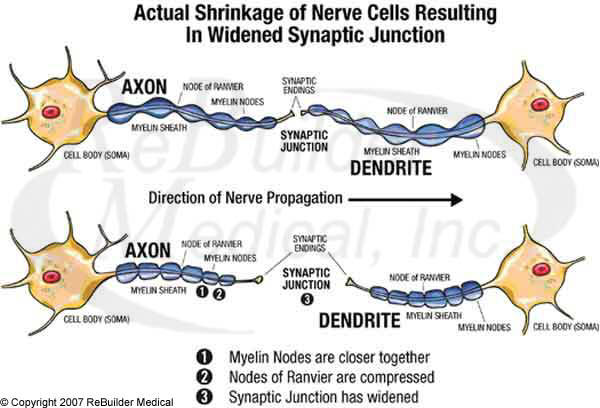
Figure 3: How a nerve cell
shrinks resulting in a widened synaptic junction.
Neuropathy
and chronic pain: the Causes
Trauma:
Actual trauma is one of the major causes of
neuropathy and chronic pain, and results when the
myelin sheath is cut or etched away by
chemotherapeutic agents, environmental toxins,
poorly performed injections, or from amputations and
accidents. Traumatic causes must obviously be
mitigated by removing the cause as in drug therapy,
chemotherapy, physical entrapment, and environmental
poisons. Permanent tissue damage may be beyond the
scope of any therapy. When these conditions are
removed, the ReBuilder® may be a helpful adjunctive
therapy in the healing process.
Diabetes: Diabetes can also
trigger neuropathy and chronic pain by affecting the
levels of glucose and/or insulin in the blood
stream. When this occurs, minerals are driven out
of the fluid in the synaptic junction thereby
reducing conductivity and impairing nerve impulse
transmission. Nerve signals propagates from the
cell body unidirectionally over the synapse, first
along the axon and then across the synapse to the
next nerve or muscle cell. The synaptic cleft, the
gap between presynaptic terminal and postsynaptic
terminal, has a thickness of 10 - 50 nm. The fact
that the impulse transfers across the synapse only
in one direction, from the presynaptic terminal to
the postsynaptic terminal, is due to the difference
in electrical polarity between the sending axon and
the receiving dendrite. This is one of the
reasons that the ReBuilder® sends its signal from
one foot to the other – it sets the relative
potential in each gap properly so that it forces the
signal to jump properly, always toward the central
nervous system and not miss-fire and jump the wrong
way, perhaps to a sending axon that can lead to the
periphery.
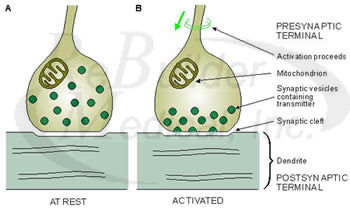
Figure 4
(A) At rest synaptic vesicles.
(B) Activated synaptic vesicles (when activation
reaches the presynaptic terminal, electrical signals
jump across the synaptic cleft to activate the
postsynaptic terminal).
As a result of hypoxic cellular atrophy, nerve
signals must now try to jump a larger gap through a
less conductive medium. This loss of nerve
transmission is first perceived as tingling, then
burning, and finally as pain when the
demineralization and gap widening process
progresses. The initial perception associated with
atrophied nerves and enlarged synaptic gaps is
tingling as some of the normal signals are
misdirected to nearby nerves. As the condition
progresses, it happens more and more until more
signals are misdirected than properly propagated,
and the resulting sensation is one of pain.
Finally, after the nerve signals can no longer be
transmitted at all, numbness is the primary
complaint. This secondary effect of neuropathy and
chronic pain reduces the strength of the calf
muscles which, in turn, reduces the blood flow to
the lower extremities. This condition often results
in poor tissue perfusion, insecure gait, balance
problems, and other mobility issues.
Chemotherapeutic Agents: Prescribed
for cancer precisely because they inhibit fast
growing or fast acting cells, chemotherapeutic
agents cause neuropathy and chronic pain in
approximately one third of the patients to whom they
are administered. Though nerve cells do not
reproduce themselves like cancer cells do, they do
change electrical states quickly and are thus
particularly susceptible to the effects of
chemotherapeutic drugs. The fast acting nerves are
mistaken for fast growing neo-plasms. Chemotherapy
has the effect of de-mineralizing the synaptic
fluid, damaging the integrity of the nerve cells,
and making it difficult for the ionization of the
cell membranes to propagate the signal along the
surface of the nerve. When ionization takes place,
the outer membrane of the nerve cells change from
positive to negative in a wave like motion taking a
positive charge from one end of the nerve all the
way to the other end. Chemotherapy is designed to
interrupt the ability of the cell to control the
permeability of the outer membrane and this process
is electrically modulated. This electrical
interruption is misapplied when the agent is in
contact with the myelin sheath of a healthy, active
nerve cell and causes the nerve cell to “short out”
and inhibit the necessary different potentials in
the nodes of the myelin sheath.
Cardiovascular Disease:
By reducing the amount of blood that can perfuse
the tissue of the lower legs and feet,
cardiovascular disease can also cause neuropathy and
chronic pain. When the arteries and veins become
blocked, blood flow is reduced. One of the first
symptoms is intermittent claudication which results
in a reduction in the distance a patient can walk
before the onset of localized leg pain due to
reduced oxygen availability. Therefore, the muscle
cells switch from aerobic metabolism to using
anaerobic metabolism thereby creating greater than
normal amounts of lactic acid, the by-product of
muscle metabolism. The increased lactic acid
collects in the cells causing inflammation and pain.
Lumbar Trauma: Trauma to the lumbar
area of the back can be another cause of neuropathy
and chronic pain. This trauma can be as slight as
lifting a bag of groceries out of the trunk, picking
up a grandchild, or bending down to tie a shoe. Our
studies show a 60% correlation between repeated
injuries to the lower back and subsequent
development of neuropathy and chronic pain symptoms.
During the acute phase of localized trauma,
inflammation develops reducing arterial and venous
blood to the lumbar synaptic junctions. Nerves in
the region temporarily shrink due to the reduction
in activity. Since the body tends to conserve
resources, the affected nerves begin to atrophy, the
synaptic junction gap begins to widen, and synaptic
minerals leech away making signal transmission more
difficult.
Signals of normal
strength can no longer cross synapses that are
damaged by the reduction in blood flow. The loss of
signals across the synapses compounds the process of
deterioration. Muscle atrophy and a host of other
problems follow. We have found that a signal
delivered at 7.83 cycles per second (the body's
natural electromagnetic resonant frequency) and at
an amplitude approximately 10 times that originally
required will cross these enlarged synapses,
repolarize them.
High Blood Pressure Medication:
High blood pressure medication not only lowers blood
pressure, it also reduces the ability of the
arterial blood to refill the veins. This vacancy
results as the venous muscle pumps the blood back to
the heart. When this occurs the blood has a
tendency to pool in the lower extremities; the
nerves and synaptic junctions do not have enough
necessary nutrition and oxygen to maintain their
health resulting in nerve cell atrophy, loss of
mineralization, and conductivity of the synaptic
junctions as explained above.
Psychoactive Drug Therapy: These
drugs, used to reduce anxiety or seizures, have the
effect of reducing the intensity/frequency of all
nerve signals. This, too, can result in loss of
motor and sensory nerve function. These conditions
can result in impaired mobility and balance issues
due to the loss of muscle strength. Whenever
overactive nerves that might be causing
psychological problems are depressed, they depress
borderline poorly functioning nerves as well.
The
ReBuilder®
Works on Three Separate, but Simultaneous Levels
Electro Stimulation of
Nerves: The ReBuilder’s®
electrical signal is a compilation of two signals
transmitted simultaneously. One signal is
specifically designed to stimulate the nerves
themselves and has a very narrow waveform with a
small amount of current under the curve and a
relatively high transient voltage
(characteristically 40 to 90 volts ac.). The
resulting current is miniscule and much below what
is commonly found with traditional TENS devices. A
larger than normal signal must be used because of
the widening gap between the nerve cells (See Figure
3) and the loss of much of the conductivity in the
synaptic junction fluid due to demineralization (See
Figure 2) the ReBuilder’s® nerve stimulation signal
is many times stronger than the normal afferent and
efferent signals; therefore, it can effectively
complete the circuit. This stimulates the nerves
causing them to re-establish their normal metabolic
function. This signal, crossing the synaptic
junctions, also re-polarizes the junctions causing
them to be receptive to reabsorb minerals thus
improving the conductivity.
Electro Stimulation of
Muscles: The
ReBuilder’s® second signal, which overlays the nerve
stimulation signal, is designed to stimulate the
muscles. This signal has a different, wider
waveform with a larger sub-threshold amount of
current under the curve and a much smaller voltage
(5 to 20 vac.). Muscles are most responsive to this
waveform. This signal causes the muscles of the
feet, calves, thighs, and buttocks to contract and
relax in harmony with the ReBuilder’s® signal.
Overcoming any residual inflammatory resistance to
blood flow, the ReBuilder’s® proprietary signal also
has specific characteristics that cause a complete
relaxation of the muscles’ fast and slow twitch
cells between each contraction stimulus. In order
for the venous pressure to move the blood through
the muscles bringing oxygen and nutrients and taking
away accumulated lactic acid, the muscle fibers
cannot remain in spasm. Adequate blood flow can
only occur in a flaccid muscle. This is an
important consideration. It is not the contraction
but primarily the time interval between the
contractions that contribute to the increased
perfusion of blood through the oxygen starved
tissue.
If the frequency of
the muscle stimulation signal is too fast, it does
not give the muscle the appropriate time necessary
to fully relax. If the signal’s frequency is too
slow, the muscle cannot entrain and recruit enough
fibers for a sustained contraction. By stimulating
the muscles to contract in this manner in response
to the ReBuilder's® signal, the venous muscle pump
is used to propel blood, against gravity, back up
towards the heart. Blood flow is increased with
mineral enriched blood which results in a flushing
of metabolic byproducts. This not only offers
relief of pain from the build up of excessive lactic
acid, but it also triggers the creation of new
muscle mass. The synaptic junctions, bathed with
this mineral rich blood, are now able to permanently
conduct the nerves signals more effectively and
efficiently.
Combined Electro Stimulation at 7.83
Hz: This twin electrical
signal (one to stimulate the nerve cells and the
other to trigger muscle cells) is pulsed on and off
at the frequency of 7.83 cycles per second. We have
found that the human body is particularly sensitive
to this frequency. One postulation for this
sensitivity is that the electrical potential between
the earth's atmosphere and the earth’s surface is
also approximately 7.83 Hz. Using this signal
frequency, we have found that the body not only
responds favorably but the brain is induced to
release large amounts of endorphins. Endorphins,
internal analgesics as powerful as and chemically
related to morphine but without any negative side
effects, are created and modulated by the body’s own
chemistry. The effect of this endorphin release is
a generalized sense of well-being, a reduction in
pain and anxiety levels elsewhere in the body, and
even a reduction in emotional pain. This ensures a
very high level of patient compliance not only
because the patient feels good physically during the
massage-like treatment period but because he/she
feels better emotionally afterward experiencing a
reduction in global non-neuropathic (nociceptive)
pain for a period of 4 to 6 hours.
An additional feature of the ReBuilder® is its
simultaneous weighted DC signal. This intentional
imbalance to the asymmetric waveform that results in
a tiny DC current is designed to stabilize the
trigger threshold that regulates the sensitivity of
the nerve cell. Like a heart in fibrillation, this
normally stable trigger level begins an unregulated
oscillation that can result in erratic transmission
of incoming nerve signals. Sometimes small signals
are accepted for an attempt at propagation, and
sometimes only large signals are accepted. This
upsets the homeostasis of the part of the brain
assigned to managing these signals and selecting the
appropriate response. By sending this constant DC
signal, the effect is to hold this resting potential
at a fixed voltage long enough for the cell to
stabilize itself and regain control.
When the conductive rubber electrodes are applied to
feet, the current path is directed from one foot, to
the ankle, up to the knee, the thigh, the lumbar
area, down the other leg all the way to the foot.
This means that all the nerves of both legs are
stimulated simultaneously as well as all the
muscles. This is a unique aspect of the ReBuilder®.
The ReBuilder® contributes to the healing process
by accomplishing the following:
-
Stimulates leg
muscles to contract and relax thereby increasing
blood velocity and volume with fresh blood to
the nerves and muscles.
-
Stimulates all
the afferent and efferent nerves in the lower
extremities with a signal larger than normal to
re-establish the pathways for subsequent normal
signals to follow.
-
Draws axon and
dendrite nerve endings closer together to
facilitate proper nerve transmission.
-
Builds residual
pain relief each time the system is used.
-
Causes the brain
to release endorphins that reduce global pain
and anxiety.
-
Promotes the
healing of non plantar surface diabetic skin
ulcers and sprains.
-
Increases muscle
strength for safe, pain free walking.
-
Promotes better
mobility and balance as proprioception returns
to the legs and feet.
-
Reduces edema as
muscle contractions encourage lymphatic drainage
and movement to the proper nodes.
-
Increases
collateral circulation, stimulating vasogenesis.
The ReBuilder®
accomplishes these functions in a simple to use home
care system that is not only effective in helping
relieve many of the symptoms of neuropathy and
chronic pain and in limiting its progression, but
can cause the regression of pain, burning, and
numbness.
When the ReBuilder’s® electrical signals stimulate
the leg muscles to contract, this "venous muscle
pump" moves the mineral rich blood to the muscles
and the nerves. Osmotic pressure and the ionic
tension from the ReBuilder’s® signals successfully
jumping across the gaps then carries these necessary
minerals into the synaptic junctions between the
nerve cells helping to restore the conductivity that
is characteristically lost.
The
Electrophysiology of Electro Stimulation with the
ReBuilder®
The
activation process encompasses certain specifics
such as currents, potentials, conductivities,
concentrations, ion flows, etc. The term action
impulse describes the whole process. When
activation occurs in a nerve cell, it is called a
nerve impulse; correspondingly, in a muscle
cell, it is called a muscle impulse. The
bioelectric measurements focus on the
electric potential difference across the
membrane; thus the electric measurement of the
action impulse is called the action potential
that describes the behavior of the membrane
potential during the activation. Consequently, we
speak, for instance, of excitatory postsynaptic
potentials (EPSP) and inhibitory
postsynaptic potentials (IPSP). In
biomagnetic measurements, it is the electric
current that is the source of the magnetic
field. Therefore, it is logical to use the term
action current to refer to the source of the
biomagnetic signal during the action impulse. These
terms are further illustrated in Figure 5, below.
Since it is these action potentials that are in a
fibrillation mode similar to a myocardial
infarction, the ReBuilder® can be thought of as a
defibrillator for nerve cells.
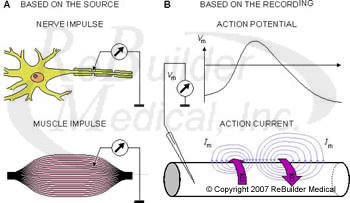
Figure 5:
Clarification of the terminology used in connection
with the action impulse:
A) The source of the action impulse may be nerve or
muscle cell (correspondingly the nerve impulse or a
muscle impulse).
B) The electric quantity measured from the action
impulse may be potential or current (correspondingly
the action potential or action current).
The concentration of
sodium ions (Na+) is about 10 times higher outside
the membrane than inside, whereas the concentration
of the potassium (K+) ions is about 30 times higher
inside as compared to outside. When the membrane is
stimulated so that the transmembrane potential rises
about 20 mV and reaches the threshold, i.e., the
membrane voltage changes from -70 mV to about -50 mV
(these are illustrative and common numerical
values), the sodium and potassium ionic
permeabilities of the membrane change. The sodium
ion permeability increases very rapidly at first,
allowing sodium ions to flow from outside to inside,
making the inside more positive. The inside reaches
a potential of about +20 mV. After that, the more
slowly increasing potassium ion permeability allows
potassium ions to flow from inside to outside, thus
returning the intracellular potential to its resting
value. The maximum excursion of the membrane
voltage during activation is about 100 mV; the
duration of the nerve impulse is around 1 ms, as
illustrated in Figure 6. While at rest, following
activation, the Na-K pump restores the ion
concentrations inside and outside the membrane to
their original values.
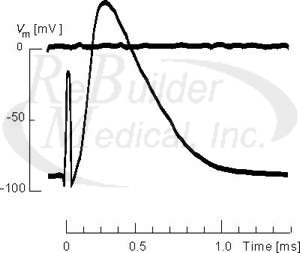
Figure 6: Nerve
impulse recorded from a cat motoneuron following a
transthreshold stimulus. The originating triggering
stimulus may be seen at t = 0.
Whether an excitatory cell is activated depends
largely on the strength and duration of the
stimulus. The membrane potential may reach the
threshold by a short, strong stimulus or a longer,
weaker stimulus. The ReBuilder’s® therapeutic
benefit depends on its use of a short voltage pulse
rather than current. Although the rheobase is very
small, to get that true net figure, a transdermal
signal must be larger and take into consideration
both the resistance of the skin and the impedance of
the body. The impedance acts as a threshold “brake”
that must first be overcome and then immediately
sensed and subsequent signals must be reduced to
avoid overwhelming the nerve potentials. The
ReBuilder® has special circuits that monitor and
control these electrical parameters in real time.
The curve illustrating this dependence is called
the strength-duration curve; a typical
relationship between these variables is illustrated
in Figure 7on the following page. The smallest
current adequate to initiate activation is called
the rheobasic current or rheobase.
Theoretically, the rheobasic current needs an
infinite duration to trigger activation. The time
needed to excite the cell with twice rheobase
current is called chronaxy.
The
Strength-Duration Curve
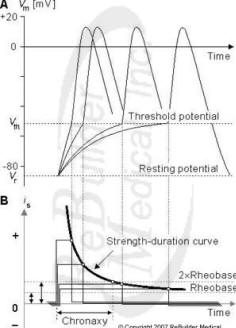
Figure 7: (A)
The response of the membrane to various stimuli of
changing strength (B), the strength-duration curve.
The level of current strength which will just
elicit activation after a very long stimulus is
called rheobase. The minimum time required for a
stimulus pulse twice the rheobase in strength to
trigger activation is called chronaxy. (For
simplicity, here, threshold is shown to be
independent on stimulus duration.)
Accommodation
and habituation denote the adaptation of
the cell to a continuing or repetitive stimulus.
This is characterized by a rise in the excitation
threshold. Facilitation denotes an
increase in the excitability of the cell;
correspondingly, there is a decrease in the
threshold. Latency denotes the delay
between two events. In the present context, it
refers to the time between application of a stimulus
pulse and the beginning of the activation. Once
activation has been initiated, the membrane is in
the absolute refractory period, and is
insensitive to new stimuli no matter how great the
magnitude. During the relative refractory
period, near the end of the activation impulse,
the cell may be activated but only with a stimulus
stronger than normal. A damaged nerve is in this
relative refractory period and that is why the
ReBuilder® sends a 10X signal.
The membrane voltage
(transmembrane voltage) (Vm) of an excitable cell is
defined as the potential at the inner surface (Фi)
relative to that at the outer (Фo) surface of the
membrane, i.e. Vm = (Фi) - (Фo). This definition is
independent of the cause of the potential whether
the membrane voltage is constant, periodic, or
nonperiodic in behavior. Fluctuations in the
membrane potential may be classified according to
their character in many different ways. Figure 8 on
the following page shows the classification for
nerve cells developed by Theodore Holmes Bullock
(1959). According to Bullock, these transmembrane
potentials may be resolved into a resting potential
and potential changes due to activity. The latter
may be classified into three different types:
-
Pacemaker
potentials: the intrinsic activity of the cell
which occurs without external excitation.
-
Transducer
potentials across the membrane, due to external
events. These include generator potentials
caused by receptors or synaptic potential
changes arising at synapses. Both subtypes can
be inhibitory or excitatory.
-
As a consequence
of transducer potentials, further response will
arise. If the magnitude does not exceed the
threshold, the response will be nonpropagating (electrotonic).
If the response is great enough, a nerve
impulse (action potential impulse) will be
produced which obeys the all-or- nothing law
(see below) and proceeds unattenuated along the
axon or fiber.

Figure 8: Trans
membrane potentials according to Theodore H.
Bullock.
Distinct and
characteristic morphologic
changes have been demonstrated in diabetic
neuropathy and chronic pain including focal and
generalized nerve fiber loss, nodal changes, blunted
fiber regeneration, and segmental demyelination. (This
segmental demyelination is a result of the shrinking
of the nerve cell which draws the nodes together.
When these nodes touch, they in effect, short each
other out and lose their integrity.) (See Figure 3
on page 3).
Pathophysiologically,
by utilizing the technique of threshold
electrotonus, diabetic neurons (myelinated and
unmyelinated) display selective reduction of inward
rectification of the potassium channel. Thus,
channel closure produces an excess of positively
charged potassium (K+) on the inner side of the
nerve membrane leading to depolarization. This also
induces the opening of both the voltage and
time-dependent calcium (Ca++) channels and sodium
(Na+) channels. Evidence suggests that this axonal
accumulation of sodium and calcium (as opposed to
the opposite leeching of these minerals from the
synaptic fluid) during dysesthetic neuropathy and
chronic pain is key to the symptoms of paresthesiae
and burning. Paresthesiae are believed to be
produced by multiple cutaneous or motor axons firing
ectopically and cyclically with alteration of
Na-K-Cyclic adenosine monophosphate (C-AMP) and
ATPase. The DC portion of the signal produced by
the ReBuilder® stabilizes the uptake of these
minerals by forcing a baseline voltage differential
and inhibiting this de-polarization phenomenon. In
addition, the application of additional biologically
available Ca balances the Ca++ and the Na+.
Some researchers
believe that a final common pathway might be a
decrease in the intra-axonal concentration of C-AMP.
Based upon the disappearance and/or significant
improvement in the paresthesiae, it is tempting to
speculate that this aberrant behavior of the fibers
is affected at the cellular level with
stabilization. Since these specific changes are
seen to a greater extent in sensory nerves and with
advanced age, it is hypothesized that ReBuilder®
bio-stimulation selectively induces
hyperpolarization or repolarization with a return to
baseline axonal potential in the sensory afferents.
The effects of this ReBuilder ®stimulation on
peripheral nerve excitability may depend on a
combination of factors including design, strength,
intensity, and duration as well as the functional
state of the peripheral nerve. To date it has been
difficult to identify electrophysiological changes
by the conventional gold standards of serial nerve
conductions and SSEP. These wave form factors that
the ReBuilder® uses are designed to mimic a normal
signal and are part of the patent pending
technology. It is the purpose of the ReBuilder® to
be an external source of stimulus to induce an
action potential impulse which will then proceed
fully along the axon.
Several general
principles have emerged from our studies. First,
electrical stimulation induces ionic gradient
changes in the Na-K-ATPase system. Since there are
distinct physiologic and neuro-biologic changes
noted at the cell membrane level, it is postulated
that repetitive sub-threshold stimulation of
afferents also induces similar ionic changes. The
most plausible explanation is that the ReBuilder®
targets the small C-fibers and induces a change in
the firing pattern of the C-fibers by recruitment,
synchronization, and possible temporal summation,
thereby producing either hyper-polarization or
re-polarization. It is well known that the
functional C-polymodal receptor afferents are
functionally adaptive and can be modulated by drugs
and temperature which act or influence their surface
membrane receptors. Similarly, stimulation by
either threshold or sub-threshold influences could
produce the same effect. It is recognized that
unmyelinated C-fiber axons comprise 75% of the axons
in cutaneous peripheral nerves in the sole of the
foot (epidermis and dermis) and have increased
utilization of potassium channels. By virtue of
this defect in the internal rectifying channel,
there is an interference with neuronal transmission
thereby producing a constant depolarization. In
Figure 9 below, the active portion (B) is reduced
and nerve propagation is inhibited in a salutatory
manner. Those nerves that are unmyelinated (A) do
not possess this feature and this is why, in
neuropathy and chronic pain, the motor neurons may
not be damaged in the same time sequence as the
sensory neurons. This observation also accounts for
the intermittent quality of the sensations or lack
thereof in the same anatomical area. The ReBuilder®
is designed to repolarize this defect in the
internal rectifying channel and because 75% of the
axons are in the plantar surface of the foot, this
is one of the ReBuilder® administers its signals via
the foot.

Figure 9:
Conduction of a nerve impulse in a nerve axon.
(A)
Continuous conduction in an unmyelinated axon.
(B) Saltatory conduction in a myelinated axon.
Since dramatic
benefits are seen in diabetic patients, it is
presumed that the ReBuilder® stimulation induced
alteration of the nociceptive threshold (which
depends on voltage-flux, flux density, time, and
usage) leads pain modulation. This is the well
known strength-duration relationship. These factors
are all a part of the patent pending technology of
the ReBuilder®. Examples of nociceptive pain
include sprains, bone fractures, burn, bumps,
bruises, inflammation (from an infection or
arthritic disorder), obstructions, and myofascial
pain (which may indicate abnormal muscle stresses).
Nociceptors are the
nerves which sense and respond to parts of the body
which suffer from damage. They signal tissue
irritation, impending injury, or actual injury.
When activated, they transmit pain signals (via the
peripheral nerves as well as the spinal cord) to the
brain. The pain is typically well localized,
constant, and often with an aching or throbbing
quality. Visceral pain is the subtype of
nociceptive pain that involves the internal organs.
It tends to be episodic and poorly localized.
Our research is
finding that regardless of the absence of
electrodiagnostic sensitivity, the morphologic and
pathophysiologic changes raise several interesting
questions. Axonal damage indicative of physical
shrinkage along a longitudinal axis was seen in all
the subjects with 100% loss of sensory action (SNAP)
and 60% loss of compound motor potentials (CMAP).
Despite this extensive damage, there was dramatic
subjective, statistically significant benefit in 90%
of the patients using the ReBuilder® in a clinical
setting.
Since it is assumed
that there is both A and C-fiber damage, the current
results suggest this observed high frequency of
regenerating axons, likely related to transient
hypoxia, may be relevant to the benefits seen. This
lack of available oxygen to the nerve cells has a
cascading effect resulting in specific metabolic
abnormalities that have been identified in diabetic
neuropathy and chronic pain. Some of these include
a reduction in nerve-free myoinositol, a reduction
in the rate of synthesis and transport of
intra-axonal proteins, a reduced incorporation of
glycolipids, electrolytes and amino acids into
myelin, a reduction in nerve Na-K-AT-Pase, and
excessive glycogen accumulation. It has also been
documented that elevated glucose levels evoke a rise
in the intracellular ATP levels thereby closing the
potassium channel. Increased glucose levels also
cause sore muscles from the conversion to lactic
acid in the muscles which farther reduces blood flow
and exacerbates hypoxia.
The idea that a
single ReBuilder® treatment can induce a change in
the firing pattern of the C-fibers is novel and
appealing. However, one cannot ignore the
therapeutic benefit over a longer period. Patients
using the ReBuilder® clearly showed an accumulating
improvement, particularly those with underlying
diabetic neuropathy and chronic pain.
The intriguing issue
of neuroprotection needs to be addressed. Does the
ReBuilder® treatment delay the progression of
peripheral nerve damage? So far follow up data
suggests that it does.
As mentioned above,
electrical stimulation alteration of the nociceptive
threshold depends on voltage-flux, flux, density,
time, and usage. According to Faraday’s Law, a
magnetic field (created by the ReBuilder’s® current
path) will exert a force on a moving ionic current.
Furthermore, an extension of this physics principle
known as the Hall Effect holds that when an
electromagnetic field is perpendicular to the
direction of flow, it will generate a secondary
intracellular voltage and secondary heat. Since
peripheral nerves in diabetic neuropathy and chronic
pain have impaired blood flow with endoneurial
hypoxia secondary to nerve micro vessel damage, it
is tempting to speculate that improvement in the
micro vascular circulation is also reflected in the
feeling of warmth which may be due to an improvement
in local and regional blood flow.
Safety
Considerations
As intermittent
electrical signals are received into the nervous
system, the resistance, capacity, and impedance
changes dramatically on a dynamic basis. This
change must be monitored and the voltage, current,
and other electrical parameters must be adjusted in
real time. Unless an electrical device incorporates
the safety features unique to the ReBuilder®, either
the patient can be injured or the instrument will be
damaged. Therefore the clinician should not
be tempted to try to stimulate the nerves and
muscles simultaneously with a normal TENS or EMS
device. The ReBuilder® has patented
technology built in which samples the patient’s
electrical parameters over 25,000 times per minute
and automatically adjusts the output to ensure the
patient’s safety. This, coupled with the both the
power supplied by a 9 volt battery and the
electronic circuits inside the unit being
electrically isolated from the direct contact with
the patient, insures complete safety.
- END
A Few Physician
Testimonials
A growing number of physicians are using the
ReBuilder® to aid their neuropathy and chronic pain
patients .
FOOT CARE CENTER, P.L.C.
Augustine Drive
Charles Town, WV 25414
Dear Dr. Phillips:
The ReBuilder® has been extremely successful with my
patients' difficult Diabetic …pain. As a podiatrist
and local board member for the ADA, I have the
pleasure of being able to treat many diabetics. I
know you are aware, that even in well controlled
diabetics, …pain can occur, and is often their
primary complaint. It can prevent sleep and
drastically alter their quality of life. Until I
tried your ReBuilder®, I had only moderate success
with expensive pharmaceuticals.
The ReBuilder® is easy to use, requiring only about
five minutes of explanation. My patients have been
very compliant due to the pain relief they receive
by using it; and they have had no side effects.
I hope this letter will encourage others to try the
ReBuilder®. My patients are grateful that we have
been able to reduce their pain without increasing or
adding medications. If you have any physician
considering prescribing the ReBuilder®, it would be
my pleasure to discuss it with them.
James R. Arnold, DPM
My friend reported that our patient had found a new
device on the internet, bought it, used it, and now
was asymptomatic after two months without drugs. I
was cautiously intrigued, and requested that he
return for a follow up so I could test him again to
see if there was any objective, measurable,
improvement. To my surprise and delight, I found
that his NCV test was now normal. I requested full
documentation from ReBuilder™ Medical and read with
interest their monograph from the inventor, David B.
Phillips, and found it to be highly accurate,
educational, and taxing to read because of its
intensive technical nature. However, it explained a
new concept that makes total sense.
I now prescribe the ReBuilder™ routinely. Of the
20 patients in my practice who have used the
ReBuilder™, all but one have experienced significant
relief. Six patients were diagnosed with ideopathic
neuropathy, 7 were diagnosed with impingement
syndrome in the lower back or buttocks, and 6
suffered from diabetes. The one who did not
respond suffers from long term uncontrolled diabetes
and has the "stocking feet" dark discoloration of
his ankles and feet and has periodic glucose levels
exceeding 500, with an AIC of 13.
I urge all medical professionals who see patients
with neuropathic symptoms to prescribe the ReBuilder™
as the preferred treatment before they have to
resort to prescription drugs.
B.D.Cowan, MD (board certified neurologist)
-
References
Berne RM, Levy MN (1993): Physiology, 3rd ed.,
1091 pp. C. V. Mosby, St. Louis.
-
Bullock TH
(1959): “Neuron Doctrine and Electrophysiology”.
Science 129:(3355) 997-1002.
Ganong WF (1991): Review of Medical Physiology,
15th ed., Appleton & Lange, Norwalk, Conn.
Guyton AC (1992): Human Physiology and
Mechanisms of Disease, 5th ed., 690 pp.
Saunders, Philadelphia.
-
|Kandel ER,
Schwartz JH (1985): Principles of Neural
Science, Elsevier Publishing, New York.
-
Lorente de Nó R
(1947): A Study of Nerve Physiology, 293 pp.
Rockefeller Institute for Medical Research, New
York.
-
Muler AL, Markin
VS (1978): “Electrical Properties of Anisotropic
Nerve-Muscle Syncytia – II”. Spread of flat
front of excitation. Biophys. 22: 536-41.
-
Patton HD, Fuchs
AF, Hille B, Scher AM, Steiner R (eds.) (1989):
Textbook of Physiology, 21st ed., 1596 pp. W. B.
Saunders, Philadelphia.
-
Ruch TC, Patton
HD (eds.) (1982): Physiology and Biophysics,
20th ed., 1242 pp. W. B. Saunders, Philadelphia.
-
Schadé JP, Ford
DH (1973): Basic Neurology, 2nd ed., 269 pp.
Elsevier Scientific Publishing, Amsterdam.
Thompson CF (1985): The Brain - An Introduction
to Neuroscience, 363 pp. W. H. Freeman, New York
.png)

The ReBuilder
|